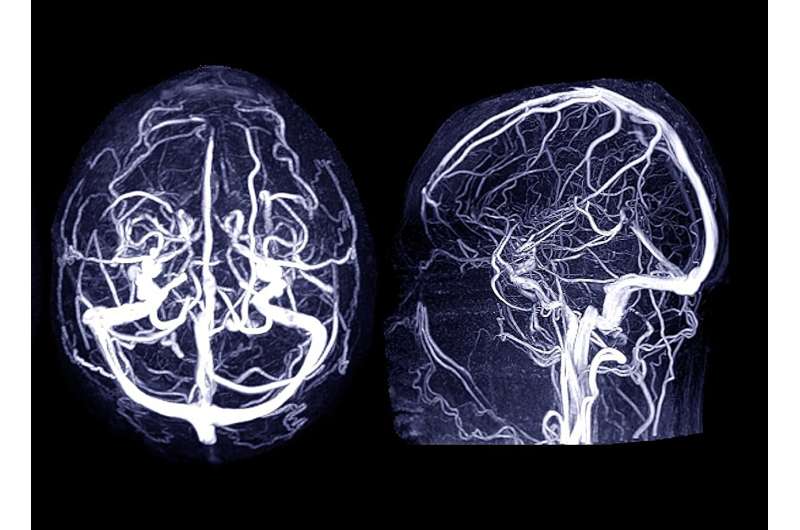This article has been reviewed according to Science X's editorial process and policies. Editors have highlighted the following attributes while ensuring the content's credibility:
fact-checked
reputable news agency
proofread
What is a cerebral aneurysm and what are the signs?

Cerebral aneurysms: For most people, the word signals a sudden, fatal brain bleed that seemingly comes out of nowhere.
However, an expert at Penn State Health says that in many cases these brain blood vessel ruptures are spotted early, before they rupture. And even when they do occur, they are not uniformly fatal.
What is a cerebral aneurysm?
"An aneurysm is like a blister on a water hose," explained Dr. Scott Simon, a neurosurgeon at Penn State Health's Milton S. Hershey Medical Center. "They can happen on any blood vessel in the body."
The trouble is, as they form in the brain in their earliest stages, most people have no idea they're in any danger. Sometimes, a doctor may spot one in a brain scan conducted for other reasons, Simon said.
If a cerebral aneurysm does rupture, about half of the time the event proves fatal, Simon said. Among those who survive, 68% will experience permanent neurological damage. According to Simon, cerebral aneurysms take the lives of half a million people around the world each year.
Cerebral aneurysm causes and risk factors
According to Simon, the simple answer as to what causes a cerebral aneurysm is, "We don't know."
Certain risk factors do seem to come into play, however.
"We know that they can run in families," he said in a Penn State news release. "We know that they happen more frequently in smokers. But we see plenty of patients without a family history who do not smoke. Some combination of genetic and environmental factors that we have yet to fully elucidate."
According to the Brain Aneurysm Foundation, the bulk of people who suffer a cerebral aneurysm are between the ages of 35 and 60, but these ruptures can occur at any age, even in childhood.
Gender does seem to matter, with aneurysms more common in women than men, especially after the age of 55.
Black Americans and Hispanic Americans tend to be at higher risk than white Americans.
Cerebral aneurysm symptoms
Unfortunately, in many cases there are no warning signs or symptoms, because these ruptures can occur suddenly, Simon said. Most of these breaks in a blood vessels are about 1/8 of an inch to just under an inch in size, and most often they affect an artery at the base of the brain.
However, as an aneurysm slowly grows, warning signs can occur. According to the National Institutes of Health, these include:
- pain above and behind the eye
- numbness
- weakness
- paralysis on one side of the face
- a dilated pupil in the eye
- vision changes or double vision
Still, symptoms do not often lead to a diagnosis, Simon noted.
"The vast majority of patients get a head scan for some other reason, like a stroke or a TIA [transient ischemic attack] and their aneurysms are discovered incidentally," Simon said.
If an aneurysm does rupture, internal hemorrhage occurs, often bringing on what feels like a severe headache. At this point, symptoms can include:
- double vision
- nausea
- vomiting
- stiff neck
- sensitivity to light
- seizures
- loss of consciousness (either brief or prolonged)
- cardiac arrest
In many cases, "we worry it can cause a subarachnoid hemorrhage," Simon added. "Subarachnoid is the space in the brain where the blood goes. Unfortunately, it carries with it a 40% mortality rate."
In many cases, a ruptured aneurysm can trigger an ischemic stroke. According to the Brain Aneurysm Foundation, up to 5% of strokes might be triggered in this way. Fifteen percent of people who experience this type of event die instantly or in the ambulance on the way to the hospital.
Cerebral aneurysm treatment
According to Simon, if a brain aneurysm is spotted prior to rupture, there is often little that is done except bring the patient in for regular monitoring.
That's because "often aneurysms don't rupture, grow or cause problems, and doctors opt to keep them under surveillance to make sure they stay that way," according to the news release.
Sometimes a developing aneurysm will pose an imminent threat, and in these cases doctors may recommend surgery to remove it. These procedures carry their own risks, however, so physicians will carefully consider the patient's age, health and the lesion's location in the brain.
How to prevent cerebral aneurysm
At this point, experts do not recommend testing for an aneurysm for most people.
If your family includes more than one person who's suffered a cerebral aneurysm, however, testing once every five years might be recommended. This would involve CT scans or MRIs.
Cutting out smoking and keeping your blood pressure under control are two ways to help reduce your risk for an aneurysm, Simon said. But as of now, there's no proven prevention strategy.
Copyright © 2024 HealthDay. All rights reserved.




















